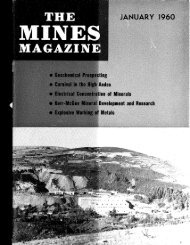What to do about CO2 - Mines Magazine - Colorado School of Mines
What to do about CO2 - Mines Magazine - Colorado School of Mines
What to do about CO2 - Mines Magazine - Colorado School of Mines
Create successful ePaper yourself
Turn your PDF publications into a flip-book with our unique Google optimized e-Paper software.
People watch<br />
Alumnus Hits the Slopes<br />
for Research and Recreation<br />
By Maureen Keller<br />
<strong>do</strong>gs and probes is a slow, tedious, <strong>of</strong>ten<br />
dangerous process.<br />
Modroo’s research proved that GPR can find humans buried<br />
beneath snow, but the technology is still a long way from being<br />
implemented for avalanche search and<br />
rescue operations. GPR units cost <strong>about</strong><br />
$30,000 each and are designed for<br />
exploration. <strong>What</strong> is needed for search<br />
and rescue is a system that could fit on<br />
the skids <strong>of</strong> a rescue helicopter that<br />
would fly over avalanche sites. Designing<br />
a pro<strong>to</strong>type could cost as much a $1<br />
million, says Modroo. He has presented<br />
his research at two international conferences, but has no takers<br />
so far.<br />
Modroo proved the ability<br />
<strong>of</strong> GPR <strong>to</strong> locate bodies<br />
by burying a dead pig and<br />
beaming radar at it.<br />
“If my research continues, we could develop s<strong>of</strong>tware <strong>to</strong> interpret<br />
data that could make GPR more user-friendly,” Modroo says. “It’s<br />
a technology I know will get implemented eventually, but it’s<br />
expensive and there’s not much motivation <strong>to</strong> <strong>do</strong> it right now. But<br />
I see it evolving.”<br />
People watch<br />
Justin Modroo BSc Geop ’01, MSc Geop ’04 combined his love <strong>of</strong><br />
skiing with academics when he earned a master’s degree at <strong>Mines</strong><br />
last year, proving once again that athletics and intelligence go well<br />
<strong>to</strong>gether. In 2004, Modroo was ranked 6th in the world in big<br />
mountain free (more commonly known as “extreme”) skiing. He<br />
has skied competitively since he was in elementary school and<br />
now that his studies are completed, he’s back on the circuit.<br />
But before graduation last December, Modroo’s focus was on<br />
ground penetrating radar (GPR) and its possible use for finding<br />
avalanche victims. GPR is commonly used <strong>to</strong> image the Earth’s<br />
subsurface <strong>to</strong> find electrical wires or <strong>to</strong> detect water tables.<br />
Modroo’s research proved it can also be used <strong>to</strong> detect bodies<br />
beneath snow. “Snow and ice make a great medium for using<br />
GPR,” says Modroo, “The contrast between electrical conductivity<br />
in snow and for humans is great.” Modroo proved the ability <strong>of</strong><br />
GPR <strong>to</strong> locate bodies by burying a dead pig and beaming radar at<br />
it. He discovered that a single GPR antenna wired <strong>to</strong> a lap<strong>to</strong>p<br />
could distinguish the pig from snow, backpacks, logs, even dirt<br />
clogs. The sooner an avalanche victim can be located, <strong>of</strong> course,<br />
the more likely the victim is <strong>to</strong> be found alive.<br />
Currently, avalanche victims are searched for using rescue <strong>do</strong>gs<br />
and 8-foot probes. Some back-country skiers wear personal<br />
beacons that emit a signal that can be pinpointed in case <strong>of</strong> an<br />
avalanche; however, use <strong>of</strong> the beacons is not widespread. No<br />
beacons were detected by rescuers in Utah in the massive<br />
avalanches that occurred in January. Searching for victims with<br />
26<br />
MINES SPRING 2005<br />
C0LORADO SCHOOL OF MINES<br />
27<br />
MINES SPRING 2005<br />
C0LORADO SCHOOL OF MINES

















